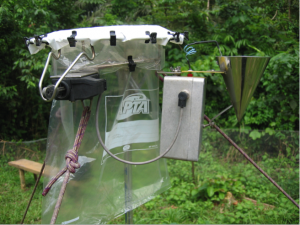Total deposition flux of insoluble atmospheric particles

Total deposition flux of insoluble atmospheric particles is collected with a passive collector of an inverted « frisbee » shape (Hall and Waters, 1986; Hall and Upton, 1988), equipped with a flow deflector ring, as tested by Wiggs et al. (2002) and full with marbles to limit dust resuspension and rain splashing. The samples are weekly collected, except in the wet season where they are also collected when the wet deposition samples are collected.

The collection procedure is decomposed into three main phases: (1) rinsing with a large volume of water, (2) decantation during more than 6 hours and siphoning of excess water; (3) drying in an oven. The collected dust is finally weighted with a precision balance (measurement uncertainty = 1 mg).
Wet deposition
Wet deposition flux of insoluble atmospheric particles

Wet deposition flux of insoluble atmospheric particles is collected using a passive MTX ARS 1010 automatic deposition sampler (MTX Italia SPA, Modane, Italy). The collector is made of two buckets (30 cm diameter) and a humidity sensor activates an aluminum lid to cover or uncover the buckets. The samples are collected weekly or after each precipitation event.
The collection procedure is the same as for the total deposition flux of insoluble atmospheric particles. It is decomposed into three main phases: (1) rinsing with a large volume of water, (2) decantation during more than 6 hours and siphoning of excess water; (3) drying in an oven. The collected dust is finally weighted with a precision balance (measurement uncertainty = 1 mg) .
Wet deposition flux of soluble species: Precipitation chemical composition
Rain water samples are collected using an automatic wet-only precipitation collector specially designed for the INDAAF (ex IDAF) network (Yoboué et al., 2005; Akpo et al., 2015; Galy-Lacaux et al., 2009). The principle of functioning is:
– The first rain droplets order to the rain detector to open the lid of the collector. The surface of rain collection is 225 cm2.
– To collect rainwater, polyethylene single-use bags are used. In order to avoid any contamination by aerosols and insects, the rain collector remains closed before and after the rain.
– After each rain event, rain samples are immediately collected by a local observator. Samples are stored in 50 mL Greiner tubes in a freezer at -18°C. After collection, samples are sent for analysis to the Laboratory of Aerology (LAERO) in Toulouse (France) in the strict respect of the cold chain, where they will be stored in freezer until analysis.
INDAAF monitoring rain network follows the GAW WMO recommendations guidelines n°160 (WMO, 2004).

Samples are analyzed for pH, Conductivity, major Inorganic and Organic ions (Cl–, NO3–, SO42-, HCO3–, CO32-, Na+, NH4+, K+, Mg2+, Ca2+, HCOO–, CH3COO–, C2H5CO–). The LAERO analytical service participates bi-annually to the WMO-GAW quality assurance program for soluble trace compounds measured by Ion Chromatography (IC). Results are available under the reference 700106 at the following address: http://qasac-americas.org/. According to these WMO inter-comparison tests, analytical precision is estimated to be 5% or better for all ions.
The annual volume weighted mean concentration (VWM) of each ion was calculated using the following relationship:

where Ci is the ion concentration for each element in µeq.L-1, Pi the precipitation amount for each rainfall event in mm, and N the total number of samples. The annual wet deposition (WD) expressed in mmol.m-2.yr-1 or kg.ha-1.yr-1 is calculated by multiplying the VWM concentrations by the annual mean rainfall amount.
References
Akpo, A.B., Galy-Lacaux, C., Laouali, D., Delon, C., Liousse, C., Adon, M., Gardrat, E., Mariscal, A., Darakpa, C., 2015. Precipitation chemistry and wet deposition in a remote wet savanna site in West Africa: Djougou (Benin). Atmos. Environ. 115, 110–123. http://dx.doi.org/10.1016/j.atmosenv.2015.04.064
Galy-Lacaux, C., Laouali, D., Descroix, L., Gobron, N., Liousse, C., 2009. Long-term precipitation chemistry and wet deposition in a remote dry savanna site in Africa (Niger). Atmos. Chem. Phys. 9, 1579-1595. https://doi.org/10.5194/acp-9-1579-2009
Hall, D.J., Upton, S.L., 1988. A wind tunnel study of the particle collection efficiency of an inverted frisbee used as a dust deposition gauge. Atmos. Environ. 22, 1383–1394.
Hall, D.J., Waters, R.A., 1986. An improved, readily available dustfall gauge. Atmos. Environ. (1967) 20, 219–222.
Wiggs, G.F.S., Leys, J., McTainsh, G.H., Heidenrich, S., Strong, C., 2002. A wind tunnel study of the collection efficiency of an aerodynamically improved “Frisbee” dust trap, in: Proceedings ICAR5/GCTE-SEN Joint Conference. Presented at the ICAR5/GCTE-SEN Joint Conference, Int. Center for Arid and Semiarid Land Studies, Texas Tech University, Lubbock, Texas, USA, pp. 133–141.
WMO, 2004. Manual for the GAW Precipitation Chemistry Programme – Guidelines, Data Quality Objectives and Standard Operating Procedures, (WMO TD No 1251).
Yoboué, V., Galy-Lacaux, C., Lacaux, J.P., Silué, S., 2005. Rainwater Chemistry and Wet Deposition over the Wet Savanna Ecosystem of Lamto (Côte d’Ivoire). J. Atmos. Chem. 52, 117-141.
